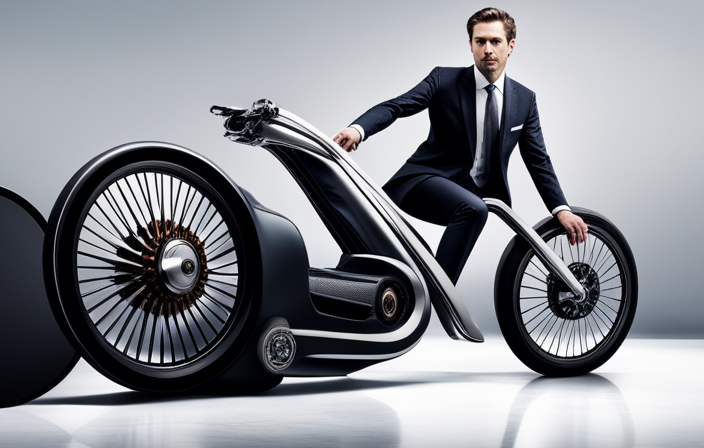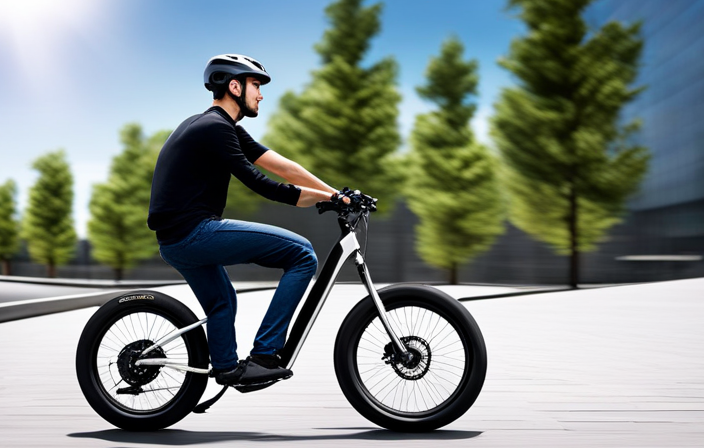Electric bike hubs are the unsung heroes of electric bicycles, quietly powering our rides without us even realizing it. These ingenious devices are the beating heart of electric bikes, delivering the power that propels us forward.
But have you ever wondered how they actually work? In this article, I will take you on a technical journey through the inner workings of electric bike hubs, explaining the intricate components and systems that make them tick.
Get ready to dive into the fascinating world of electric bike hubs and uncover the secrets behind their effortless performance.
Key Takeaways
- Electric bike hubs consist of a motor, battery, and controller to convert electrical energy into mechanical power.
- Brushless motors are more efficient and require less maintenance compared to brushed motors.
- The power of the electric motor, measured in watts, determines the speed and torque of the bike.
- Pedal assist and throttle control provide assistance and control over the bike’s speed, respectively.
Basic Components of an Electric Bike Hub
The basic components of an electric bike hub include the motor, battery, and controller. Electric bike hub manufacturers produce different types of electric bike hubs, each with its own specifications and features.
The motor is the heart of the hub, responsible for converting electrical energy from the battery into mechanical power. It is usually located in the center of the rear wheel and can vary in size and power output.
The battery provides the necessary electrical energy to power the motor, and its capacity determines the range and performance of the electric bike.
The controller acts as the brain of the system, regulating the flow of electricity between the motor and the battery.
Understanding how these components work together is crucial in understanding the electric motor function and power.
Electric Motor Function and Power
Electric bike hubs use an electric motor to generate power. The efficiency of an electric motor determines how effectively it converts electrical energy into mechanical energy.
There are different types of electric bike motors, including brushed and brushless motors. Brushed motors have a lower efficiency due to the friction caused by the brushes, while brushless motors eliminate this friction and are more efficient. They also have a longer lifespan and require less maintenance.
The power of an electric motor is measured in watts and determines the speed and torque of the bike. Higher wattage motors provide more power and are suitable for uphill rides or carrying heavier loads.
Transitioning into the subsequent section about the battery and charging system, the electric motor relies on a steady supply of power to function optimally.
Battery and Charging System
To ensure your electric bike is always ready for a ride, it’s important to understand how the battery and charging system function.
The battery is the heart of the electric bike, providing the power needed to propel you forward. It is essential to monitor the battery life to prevent unexpected power depletion during your ride.
Charging the battery is a simple process that can be done using a standard electrical outlet. However, it is worth noting that the charging time may vary depending on the size and capacity of the battery.
Additionally, it is crucial to consider the availability of charging infrastructure when planning longer rides. This ensures that you can easily find charging stations along your route if needed.
Now, let’s delve into the next section about ‘pedal assist and throttle control’ to understand how these features enhance the riding experience.
Pedal Assist and Throttle Control
Get ready to experience the thrill of effortlessly cruising on your electric bike with the help of pedal assist and throttle control.
When it comes to electric bike hubs, pedal assist and throttle control are two key features that enhance your riding experience.
Pedal assist allows you to ride with ease by providing assistance based on the force you apply on the pedals. It ensures a smooth and natural riding experience while conserving battery power.
Throttle control, on the other hand, allows you to control the speed of your electric bike with a twist of your wrist. It offers instant acceleration and is great for situations where you need a quick burst of speed.
When using pedal assist or throttle control, it is important to follow safety measures such as wearing a helmet, obeying traffic rules, and being aware of your surroundings.
Now, let’s move on to the next section about the regenerative braking system.
Regenerative Braking System
The regenerative braking system on an electric bike allows you to recharge the battery while slowing down. It works by converting the kinetic energy generated during braking into electrical energy, which is then stored in the battery for later use.
This system not only helps to extend the range of the bike but also promotes energy regeneration and reduces the need for frequent charging. The braking efficiency of the regenerative braking system is determined by several factors, including the strength and responsiveness of the braking mechanism, as well as the efficiency of the energy conversion process.
To maximize the energy regeneration, it is important to maintain the braking system in good condition and adjust it properly.
Now, let’s delve into the next section about hub gears and the shifting mechanism.
Hub Gears and Shifting Mechanism
Hub gears and the shifting mechanism allow for smooth and efficient gear changes on an electric bike. The hub gears are located inside the rear wheel hub and consist of multiple gears that can be engaged or disengaged to change the gear ratio. The shifting mechanism, usually controlled by a lever on the handlebars, is connected to the hub gears and enables the rider to shift between different gears. This system provides several advantages, including a wide range of gear ratios, less maintenance compared to traditional derailleur systems, and the ability to shift gears even when the bike is stationary.
To better understand the functionality of hub gears and the shifting mechanism, let’s take a look at the table below:
| Gear | Gear Ratio | Advantages |
|---|---|---|
| 1st | Low | Offers increased torque for uphill climbs |
| 2nd | Medium | Ideal for regular riding on flat terrain |
| 3rd | High | Provides higher speeds for downhill or fast-paced riding |
With the hub gears and shifting mechanism, riders can easily switch between different gear ratios to optimize their riding experience. Now, let’s delve into the next section about the torque sensor and power output, which plays a crucial role in electric bike performance.
Torque Sensor and Power Output
To optimize your riding experience, you’ll appreciate the importance of the torque sensor and its impact on power output.
The torque sensor is a crucial component in electric bike hubs as it measures the force applied to the pedals and determines how much motor assistance is needed. It works by detecting the pressure on the pedals and converting it into an electrical signal. This signal is then sent to the motor controller, which adjusts the power output accordingly.
This means that the more force you apply to the pedals, the more power the motor will provide. The torque sensor ensures a smooth and efficient ride by seamlessly matching the motor assistance with your pedal cadence. This technology allows for a more natural and intuitive riding experience.
Moving on to maintenance and troubleshooting tips, it is important to keep your torque sensor clean and free from debris to ensure accurate readings.
Maintenance and Troubleshooting Tips
Moving on from the Torque Sensor and Power Output, let’s now delve into the realm of Maintenance and Troubleshooting Tips for electric bike hubs.
It is important to be aware of common issues that may arise with these hubs and the appropriate troubleshooting steps to take. One common issue is a loose or misaligned hub, which can cause a wobbly ride. To fix this, simply tighten the hub’s axle nuts or realign the hub properly.
Another issue could be a worn-out hub bearing, resulting in grinding noises or restricted wheel rotation. In such cases, replacing the hub bearings is necessary.
Additionally, regular cleaning and lubrication of the hub is crucial to prevent dirt and debris buildup, ensuring smooth operation.
By following these maintenance and troubleshooting steps, you can keep your electric bike hub in optimal condition.
Now, let’s explore the benefits of electric bike hubs.
Benefits of Electric Bike Hubs
Enjoy the advantages of electric bike hubs, such as effortless cruising and a smoother riding experience. Electric bike hubs offer numerous benefits over traditional bicycles.
One of the major advantages of electric bike hub systems is their ease of use. With a hub motor, riders can effortlessly cruise along without the need for constant pedaling. Additionally, electric bike hub motors provide a quieter and smoother ride compared to other types of motors.
Another benefit of electric bike hub systems is their versatility. Electric bike hub conversion kits allow riders to transform their existing bicycles into electric bikes, providing an affordable and convenient option. Furthermore, electric bike hub kits offer a wide range of options and customization opportunities.
In conclusion, the benefits of electric bike hubs make them an excellent choice for any rider seeking an enhanced and enjoyable biking experience. Transitioning to the future developments in electric bike hub technology, exciting advancements are on the horizon.
Future Developments in Electric Bike Hub Technology
Exciting advancements in electric bike hub technology are on the horizon, with new developments expected to revolutionize the riding experience.
The integration of artificial intelligence in electric bike hub technology is one such development that holds great promise. By incorporating AI algorithms, electric bike hubs will be able to analyze data in real-time and adjust power output accordingly, optimizing the riding experience for each individual user.
Additionally, wireless connectivity for electric bike hubs will enable riders to connect their bikes to their smartphones or other devices, allowing for seamless control and customization of their riding experience. This wireless connectivity will also enable riders to receive real-time updates and notifications about their bike’s performance and maintenance needs.
Together, these advancements will make electric bike hubs smarter, more efficient, and more user-friendly, enhancing the overall riding experience for electric bike enthusiasts.
Frequently Asked Questions
How long does it take to charge the battery of an electric bike hub?
The charging time of an electric bike hub’s battery depends on its capacity. Higher capacity batteries may take longer to charge. It is important to consider the battery capacity when estimating the charging time.
Can I switch between pedal assist and throttle control modes while riding?
Sure, it’s absolutely incredible. While riding, I can effortlessly switch between pedal assist and throttle control modes. The benefits of pedal assist include increased range, improved fitness, and a more natural riding experience. It’s truly a game-changer.
What is the average lifespan of an electric bike hub motor?
The average lifespan of an electric bike hub motor depends on various factors such as usage, maintenance, and quality of the motor. Factors affecting electric bike hub motor reliability include overheating, water damage, and excessive load.
Can I use regenerative braking to charge the battery while riding downhill?
Yes, regenerative braking can be used to charge the battery while riding downhill. It offers benefits like increased range and battery life. However, drawbacks include limited charging capacity and reduced braking power compared to traditional braking systems.
Are there any specific maintenance requirements for electric bike hubs?
Maintaining electric bike hubs is a breeze! Just give them a quick wipe and they’ll be good as new. No need to worry about complex troubleshooting. These hubs are built to last and require minimal attention.
Conclusion
In conclusion, electric bike hubs are a fascinating technology that has revolutionized the way we commute and enjoy cycling.
With their efficient motor function and power, easy charging system, and pedal assist or throttle control options, electric bike hubs offer a convenient and eco-friendly transportation solution.
One interesting statistic to consider is that electric bikes can save up to 96% of carbon emissions compared to cars, making them not only a practical choice but also a sustainable one.
With ongoing developments in this field, the future of electric bike hubs looks promising.









